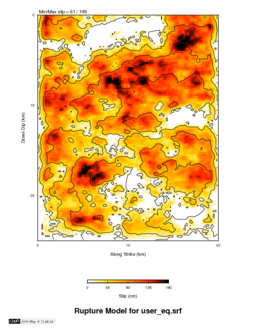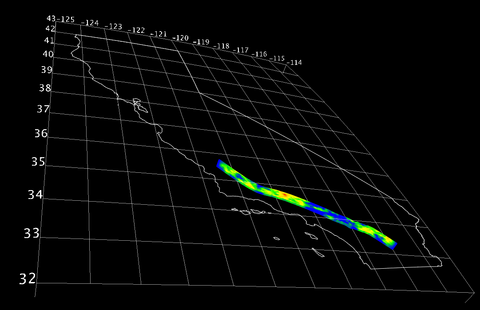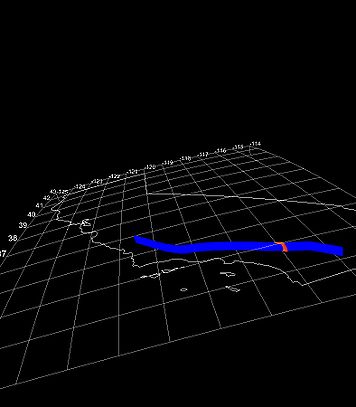Difference between revisions of "Standard Rupture Format"
| (8 intermediate revisions by the same user not shown) | |||
| Line 1: | Line 1: | ||
| − | Standard Rupture Format (SRF) is a file format defined by Robert Graves ( | + | Standard Rupture Format (SRF) is a file format defined by Robert Graves (USGS) intended to facilitate exchange of rupture descriptions between scientists. |
| − | + | == Version 2 released in 2015 == | |
| − | *[ | + | *[https://g-3a9041.a78b8.36fe.data.globus.org/SRF-Description-Graves_2.0.pdf Graves SRF Technical Definition Version 2 (pdf file)] |
| − | |||
| − | [[Image: | + | == Version 1 released in 2010== |
| + | *[https://g-3a9041.a78b8.36fe.data.globus.org/srf4.pdf Graves SRF Technical Definition (pdf file)] | ||
| + | *[https://g-3a9041.a78b8.36fe.data.globus.org/Graves_Rup_Format.ppt Graves SRF Overview Presentation (ppt file)] | ||
| + | *[https://g-3a9041.a78b8.36fe.data.globus.org/nr6.70-s0000-h0000.txt Northridge EQ in SRF format (txt file)] | ||
| + | |||
| + | [[Image:SRF.png|256px|thumb|right| Fig. 1: Example showing the contents of a Standard Rupture Format (SRF) file. Image shows geographical extent of rupture surface and final slip distribution on fault. Alternative parameters can be plotted including rupture velocity and initial stress distribution (Image Credit: Robert Graves)]] | ||
| + | |||
| + | == CyberShake Data Web Service - SRF Retrieval == | ||
| + | |||
| + | One of the requirements for the 2010 USEIT intern class was to create a Standard Rupture Format (SRF) browser plugin for SCEC-VDO. This required a tool to retrieve SRF files from the CyberShake database. The 'GETCSSRF' web service was written to allow users to retrieve the SRF files from the CyberShake database. | ||
| + | |||
| + | This web service was written as a Python web.py application. The service takes a set of arguments to select the desired file out of the CyberShake database and returns the contents of the SRF file is found. The service also supports an option to list the set of supported CyberShake Earthquake Rupture Forecast and Rupture Variation Scenario versions. | ||
| + | |||
| + | [[File:Srf_browser.png|480px|thumb|right|Fig 1: SRF Browser Plugin]] | ||
| + | |||
| + | |||
| + | Fig 1. is a snapshot of the SCEC-VDO SRF Browser Plugin displaying a SRF file retrieved with the 'GETCSSRF' service from the CyberShake Database. | ||
| + | |||
| + | A video tutorial of the SRF browser plugin and the underlying SRF retrieval web service in action created by the USEIT interns can be found here: [http://scec.usc.edu/internships/useit/scec-vdo/video1541 SRF Browser Plugin Tutorial] | ||
| + | |||
| + | |||
| + | [[File:UCERF2_M8.jpg|356px|thumb|right|Fig 2: SCEC Intern development SCEC-VDO displaying a UCERF2.0 rupture representative of the M8 rupture. SCEC-VDO animates the CyberShake SRF files showing hypocenter and rupture velocity.]] | ||
== SRF-related Wiki Entries == | == SRF-related Wiki Entries == | ||
Latest revision as of 07:23, 30 November 2025
Standard Rupture Format (SRF) is a file format defined by Robert Graves (USGS) intended to facilitate exchange of rupture descriptions between scientists.
Contents
Version 2 released in 2015
Version 1 released in 2010
- Graves SRF Technical Definition (pdf file)
- Graves SRF Overview Presentation (ppt file)
- Northridge EQ in SRF format (txt file)
CyberShake Data Web Service - SRF Retrieval
One of the requirements for the 2010 USEIT intern class was to create a Standard Rupture Format (SRF) browser plugin for SCEC-VDO. This required a tool to retrieve SRF files from the CyberShake database. The 'GETCSSRF' web service was written to allow users to retrieve the SRF files from the CyberShake database.
This web service was written as a Python web.py application. The service takes a set of arguments to select the desired file out of the CyberShake database and returns the contents of the SRF file is found. The service also supports an option to list the set of supported CyberShake Earthquake Rupture Forecast and Rupture Variation Scenario versions.
Fig 1. is a snapshot of the SCEC-VDO SRF Browser Plugin displaying a SRF file retrieved with the 'GETCSSRF' service from the CyberShake Database.
A video tutorial of the SRF browser plugin and the underlying SRF retrieval web service in action created by the USEIT interns can be found here: SRF Browser Plugin Tutorial
The following SCEC projects currently use SRF format in their rupture definitions.


